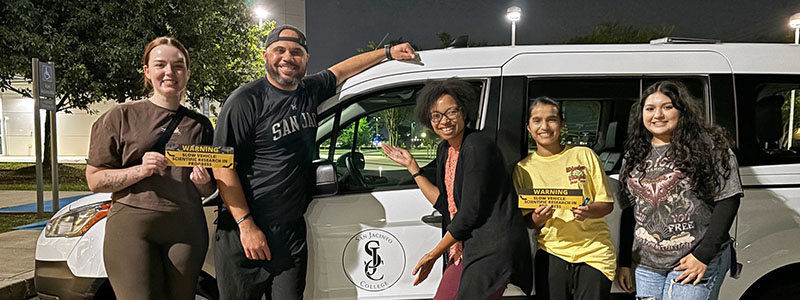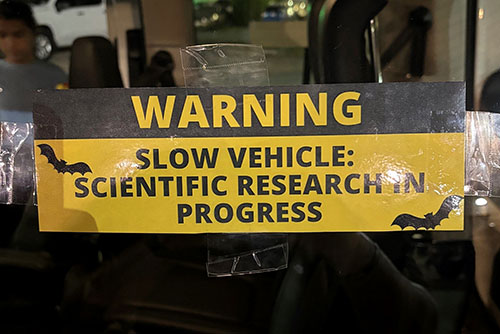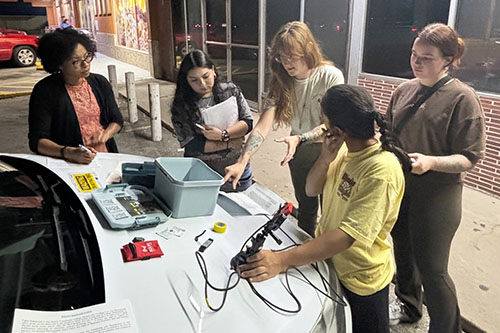Project Gotham: Student Research Gets Batty

Darkness cloaks the city.
Streetlights throw patchy light across the road. Ahead, a white van slows to 10 miles per hour at a bridge.
You brake just as your headlights illumine a yellow sign on the van’s rear window: “WARNING.”
Below, flanked by bat icons, are the words: “Slow Vehicle: Scientific Research in Progress.”
You’ve just spotted San Jacinto College’s Project Gotham team in the middle of some batty research.
Bat network
San Jac STEM department chair Dr. Tyler Olivier has championed hands-on learning since his student days trapping bats and rodents.
Learning about Olivier’s early fieldwork, a colleague connected him to Dr. Andrea Rummel, a Rice University assistant professor of biosciences who has studied bats for a decade.

Olivier jumped in.
“As a biologist, I don't find anything better than being in the field and collecting data,” he said. “This gives students the opportunity to collaborate with other scientists — people who are active in the field.”
Warning: Scientific research ahead
Launched in fall 2024, Project Gotham currently comprises seven San Jac students — three conducting the research for honors biology projects.
The team leaves 45 minutes after sunset, when bats begin foraging for insects. Olivier drives a San Jac van while students navigate and take notes.

“Bats are echolocating to situate themselves in space and identify prey that they
can then move toward, and each bat has a characteristic echolocation call,” Rummel
said.
During the 1.5-hour drive, students note the landscape at different times. Are they passing over creeks or ponds? Do any areas contain strong artificial light?
Later, students compare the calls, activity, and GPS data to their notes. One idea they’re examining is the luxury effect. Do bats appear more in affluent areas with greenspace than in bright, noisy industrial spaces?
Project Gotham makes the same drive within a week to increase the sample size and power of the results.
Project reach
Project Gotham is important on many levels.
For one, it provides more data about Houston’s natural pest control — from Mexican free-tailed to big brown bats. Each bat consumes more than half its bodyweight in insects nightly.
“Each of those bats is eating 50 insects, so that’s hundreds of thousands of insects that these guys are taking out of the air on a given night,” Rummel said.
For another, Project Gotham gives students like Rachel Abreo experience that many college juniors and seniors would envy. The dual credit student even presented her bat research at the 2025 National Conference for Undergraduate Research in April.
“This is kind of getting your feet in first,” Abreo said. “You have great people who are in higher ranks than you who are able to speak wisdom into your learning.”
This is kind of getting your feet in first. You have great people who are in higher ranks than you who are able to speak wisdom into your learning.
Drives often double as tutoring or advising sessions.
“We don't just talk about Project Gotham, but we start to talk about what's the next step as you transfer,” Olivier said. “What are some of the things you should be looking to do? What are the expectations as you get to a university, or what are your career goals?”
Research to be continued?
San Jac is the only community college participating in Rice’s bat research, though Houston Bat Team and Texas Master Naturalists also contribute.
Project Gotham will keep collecting data as long as it’s needed, but Rummel hopes to expand the project.
As for Olivier?
Recalling the hoops to launch acoustic-only research, he grins. If Phase 2 includes capturing live bats in mist nets: “I’ll be writing a grant for rabies vaccinations.”
Learn more about San Jac's STEM programs
About San Jacinto College
Surrounded by monuments of history, evolving industries, maritime enterprises of today, and the space age of tomorrow, San Jacinto College has served the people of East Harris County, Texas, since 1961. The College is ranked second in the nation among more than 1,100 community colleges, as designated by the Aspen Institute and was named an Achieving the Dream Leader College of Distinction in 2020. As a Hispanic-Serving Institution that spans five campuses, plus an online college, San Jacinto College serves approximately 45,000 credit and non-credit students annually. It offers more than 200 degrees and certificates across eight major areas of study that put students on a path to transfer to four-year institutions or enter the workforce. The College is fiscally sound, holding bond ratings of AA+ by Standard & Poor’s and Aa2 by Moody’s.
